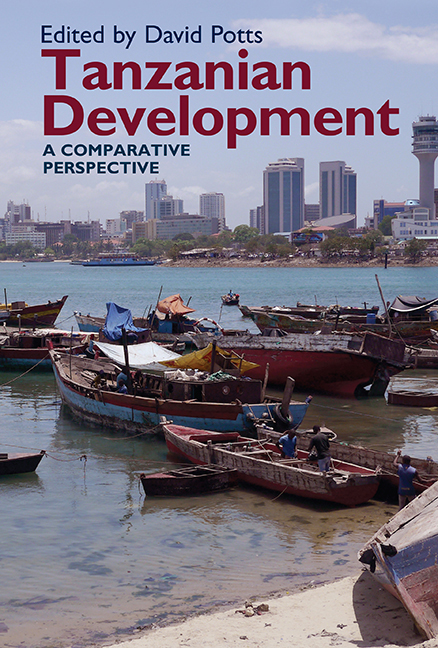Book contents
- Frontmatter
- Contents
- List of Illustrations
- Contributors
- Acknowledgements
- 1 Introduction – Tanzanian Development: A Comparative Perspective
- 2 The Political Economy of Tanzania 1967–2017: Reimagining the State
- 3 Reflections on the Tanzanian Trajectory: Decline and Recovery
- 4 Agricultural Development in Tanzania
- 5 Assets and Poverty Dynamics: The Methodological Challenges of Constructing Longitudinal Surveys in Tanzania
- 6 Contract Farming in Tanzania: Experiences from Tobacco and Sunflower
- 7 ‘We Just Sell Water – That is All We Do’: Two Cases of Small-scale Irrigation in Tanzania
- 8 The Industrial Development of Tanzania in Comparative African Perspective
- 9 Competitiveness in African Manufacturing: Some Evidence from Tanzania
- 10 ‘Good Life Never Comes Like Dreams’: Youth, Poverty and Employment in Arusha
- 11 International Aid to Tanzania – with some comparisons from Ghana and Uganda
- 12 Real Exchange Rate Changes and Export Performance in Tanzania and Ethiopia
- 13 Economic Leakage as a Constraint on Tourism's Effective Contribution to Local Economic Development in Tanzania
- 14 Extractive Industry Revenues and their Expenditure in Local Government Authorities: The Case of the Gold Service Levy in Geita District Council in Tanzania
- 15 Conclusion
- References
- Index
10 - ‘Good Life Never Comes Like Dreams’: Youth, Poverty and Employment in Arusha
Published online by Cambridge University Press: 24 October 2019
- Frontmatter
- Contents
- List of Illustrations
- Contributors
- Acknowledgements
- 1 Introduction – Tanzanian Development: A Comparative Perspective
- 2 The Political Economy of Tanzania 1967–2017: Reimagining the State
- 3 Reflections on the Tanzanian Trajectory: Decline and Recovery
- 4 Agricultural Development in Tanzania
- 5 Assets and Poverty Dynamics: The Methodological Challenges of Constructing Longitudinal Surveys in Tanzania
- 6 Contract Farming in Tanzania: Experiences from Tobacco and Sunflower
- 7 ‘We Just Sell Water – That is All We Do’: Two Cases of Small-scale Irrigation in Tanzania
- 8 The Industrial Development of Tanzania in Comparative African Perspective
- 9 Competitiveness in African Manufacturing: Some Evidence from Tanzania
- 10 ‘Good Life Never Comes Like Dreams’: Youth, Poverty and Employment in Arusha
- 11 International Aid to Tanzania – with some comparisons from Ghana and Uganda
- 12 Real Exchange Rate Changes and Export Performance in Tanzania and Ethiopia
- 13 Economic Leakage as a Constraint on Tourism's Effective Contribution to Local Economic Development in Tanzania
- 14 Extractive Industry Revenues and their Expenditure in Local Government Authorities: The Case of the Gold Service Levy in Geita District Council in Tanzania
- 15 Conclusion
- References
- Index
Summary
Introduction
Two demographic trends are changing Africa's population and poverty dynamics. Its population is forecast to treble over the next forty years (UNDP 2012), and its populations are increasingly urban and increasingly young. All but three African countries have over 40 per cent of their adult population in the 15 to 29 age category, and by 2035 the majority of Africans will be living in cities (Guengant & May 2013). The ‘power’ of youth brings both possibilities and challenges, nowhere more evident than in sub-Saharan Africa, and governments must prepare more effectively for their futures (Burgess 2005).
Cities, in particular, are a main stage for young lives across the continent (Hansen 2015). Dynamic city contexts heighten youth aspirations through their offer of economic opportunities and higher wages, infrastructure, better access to education and services, and perceptions of ‘modernity’. These factors make migration a phenomenon closely linked with youth, particularly young men (Crivello 2011; Jeffrey 2011; Honwana 2012). But a ‘crisis of youth’ looms as an increasing number of young Africans find it difficult to gain education and employment or meet standard of living aspirations (Jones & Chant 2009). Young Africans are not finding that these urban benefits and promises are translating into better social and economic mobility for their generation. Unemployment rates for youth are higher than for adults across the whole continent (Thurlow 2015). The new labour markets, education systems and consumer cultures that have accompanied urbanization mean that traditional, linear moves from youth to adulthood are unlikely (Valentine 2003; Worth 2009).
Tanzania's youth population will not peak until 2030, and with half of its population already under the age of 25, it already has the tenth largest youth population in the world (Lam 2006). Ambitions and aspirations have fuelled a wave of youth migration to urban centres (Burton 2010). One in every three children born in Tanzania today will be living in towns or cities by the time they are 20 years old (Riggio 2012). Yet cities are difficult places to be young and poor. Tanzania has struggled to translate its economic growth into significant poverty reduction (Arndt et al. 2015).
- Type
- Chapter
- Information
- Tanzanian DevelopmentA Comparative Perspective, pp. 199 - 213Publisher: Boydell & BrewerPrint publication year: 2019



